FORD F750 2015 13.G Owners Manual
Manufacturer: FORD, Model Year: 2015, Model line: F750, Model: FORD F750 2015 13.GPages: 384, PDF Size: 4.95 MB
Page 171 of 384
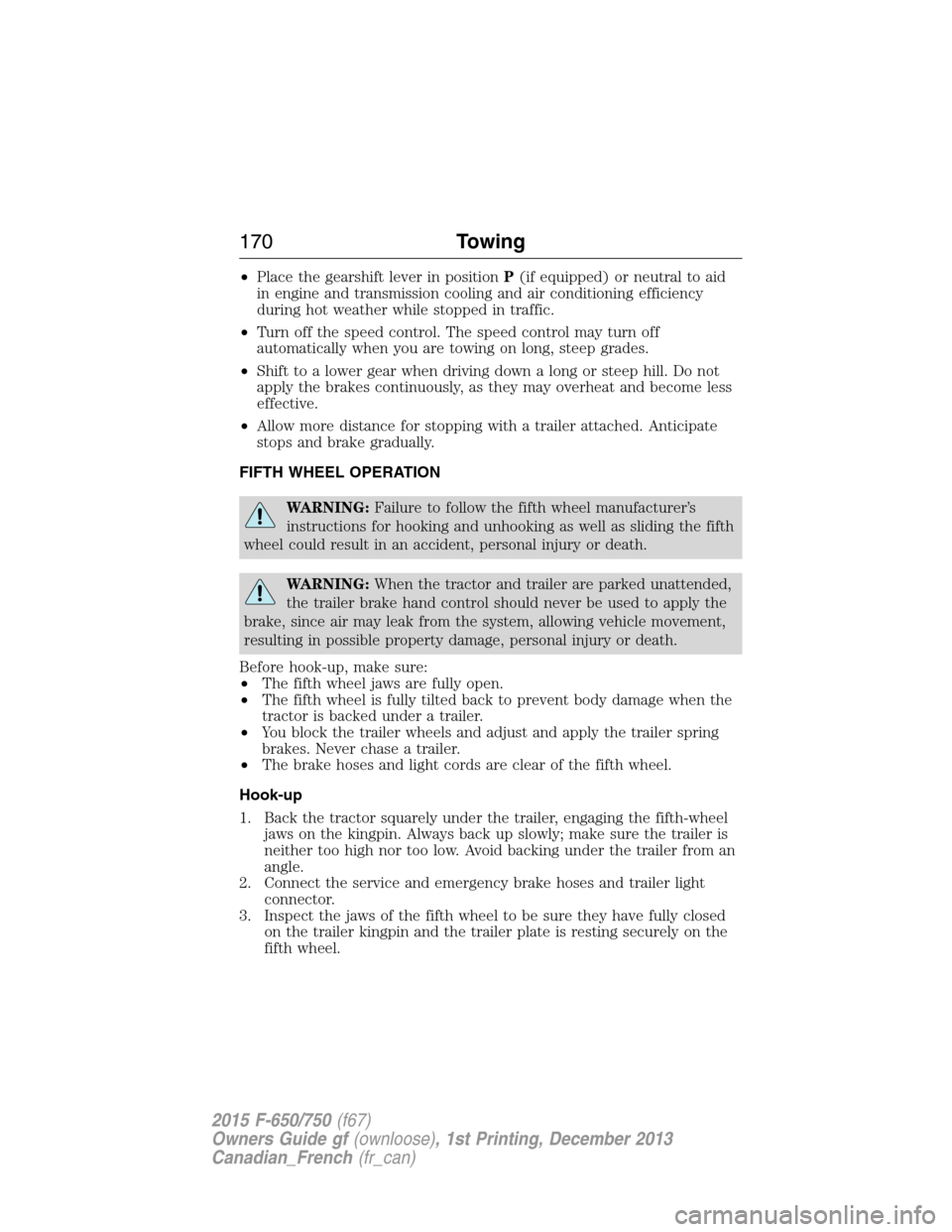
•Place the gearshift lever in positionP(if equipped) or neutral to aid
in engine and transmission cooling and air conditioning efficiency
during hot weather while stopped in traffic.
•Turn off the speed control. The speed control may turn off
automatically when you are towing on long, steep grades.
•Shift to a lower gear when driving down a long or steep hill. Do not
apply the brakes continuously, as they may overheat and become less
effective.
•Allow more distance for stopping with a trailer attached. Anticipate
stops and brake gradually.
FIFTH WHEEL OPERATION
WARNING:Failure to follow the fifth wheel manufacturer’s
instructions for hooking and unhooking as well as sliding the fifth
wheel could result in an accident, personal injury or death.
WARNING:When the tractor and trailer are parked unattended,
the trailer brake hand control should never be used to apply the
brake, since air may leak from the system, allowing vehicle movement,
resulting in possible property damage, personal injury or death.
Before hook-up, make sure:
•The fifth wheel jaws are fully open.
•The fifth wheel is fully tilted back to prevent body damage when the
tractor is backed under a trailer.
•You block the trailer wheels and adjust and apply the trailer spring
brakes. Never chase a trailer.
•The brake hoses and light cords are clear of the fifth wheel.
Hook-up
1. Back the tractor squarely under the trailer, engaging the fifth-wheel
jaws on the kingpin. Always back up slowly; make sure the trailer is
neither too high nor too low. Avoid backing under the trailer from an
angle.
2. Connect the service and emergency brake hoses and trailer light
connector.
3. Inspect the jaws of the fifth wheel to be sure they have fully closed
on the trailer kingpin and the trailer plate is resting securely on the
fifth wheel.
170Towing
2015 F-650/750(f67)
Owners Guide gf(ownloose), 1st Printing, December 2013
Canadian_French(fr_can)
Page 172 of 384
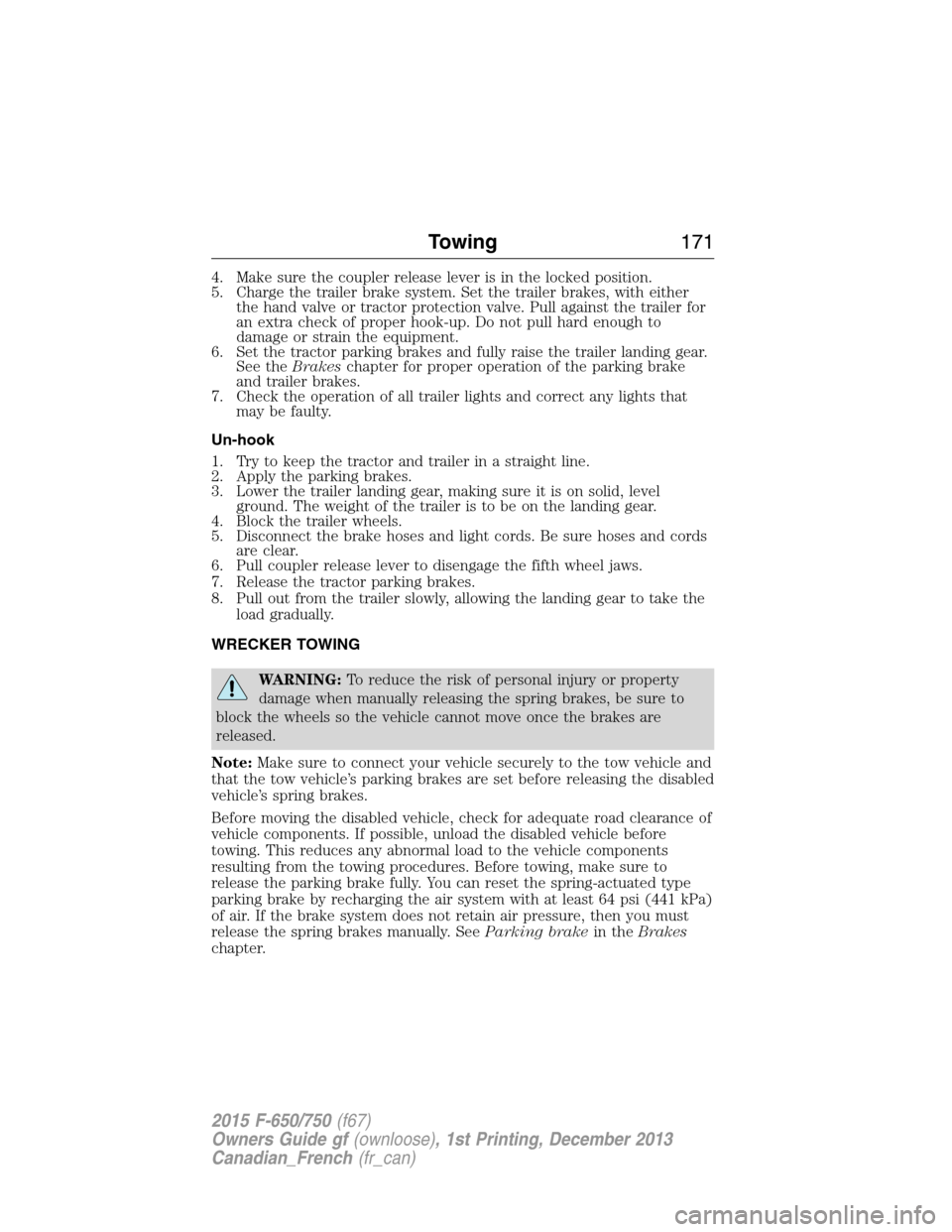
4. Make sure the coupler release lever is in the locked position.
5. Charge the trailer brake system. Set the trailer brakes, with either
the hand valve or tractor protection valve. Pull against the trailer for
an extra check of proper hook-up. Do not pull hard enough to
damage or strain the equipment.
6. Set the tractor parking brakes and fully raise the trailer landing gear.
See theBrakeschapter for proper operation of the parking brake
and trailer brakes.
7. Check the operation of all trailer lights and correct any lights that
may be faulty.
Un-hook
1. Try to keep the tractor and trailer in a straight line.
2. Apply the parking brakes.
3. Lower the trailer landing gear, making sure it is on solid, level
ground. The weight of the trailer is to be on the landing gear.
4. Block the trailer wheels.
5. Disconnect the brake hoses and light cords. Be sure hoses and cords
are clear.
6. Pull coupler release lever to disengage the fifth wheel jaws.
7. Release the tractor parking brakes.
8. Pull out from the trailer slowly, allowing the landing gear to take the
load gradually.
WRECKER TOWING
WARNING:To reduce the risk of personal injury or property
damage when manually releasing the spring brakes, be sure to
block the wheels so the vehicle cannot move once the brakes are
released.
Note:Make sure to connect your vehicle securely to the tow vehicle and
that the tow vehicle’s parking brakes are set before releasing the disabled
vehicle’s spring brakes.
Before moving the disabled vehicle, check for adequate road clearance of
vehicle components. If possible, unload the disabled vehicle before
towing. This reduces any abnormal load to the vehicle components
resulting from the towing procedures. Before towing, make sure to
release the parking brake fully. You can reset the spring-actuated type
parking brake by recharging the air system with at least 64 psi (441 kPa)
of air. If the brake system does not retain air pressure, then you must
release the spring brakes manually. SeeParking brakein theBrakes
chapter.
Towing171
2015 F-650/750(f67)
Owners Guide gf(ownloose), 1st Printing, December 2013
Canadian_French(fr_can)
Page 173 of 384
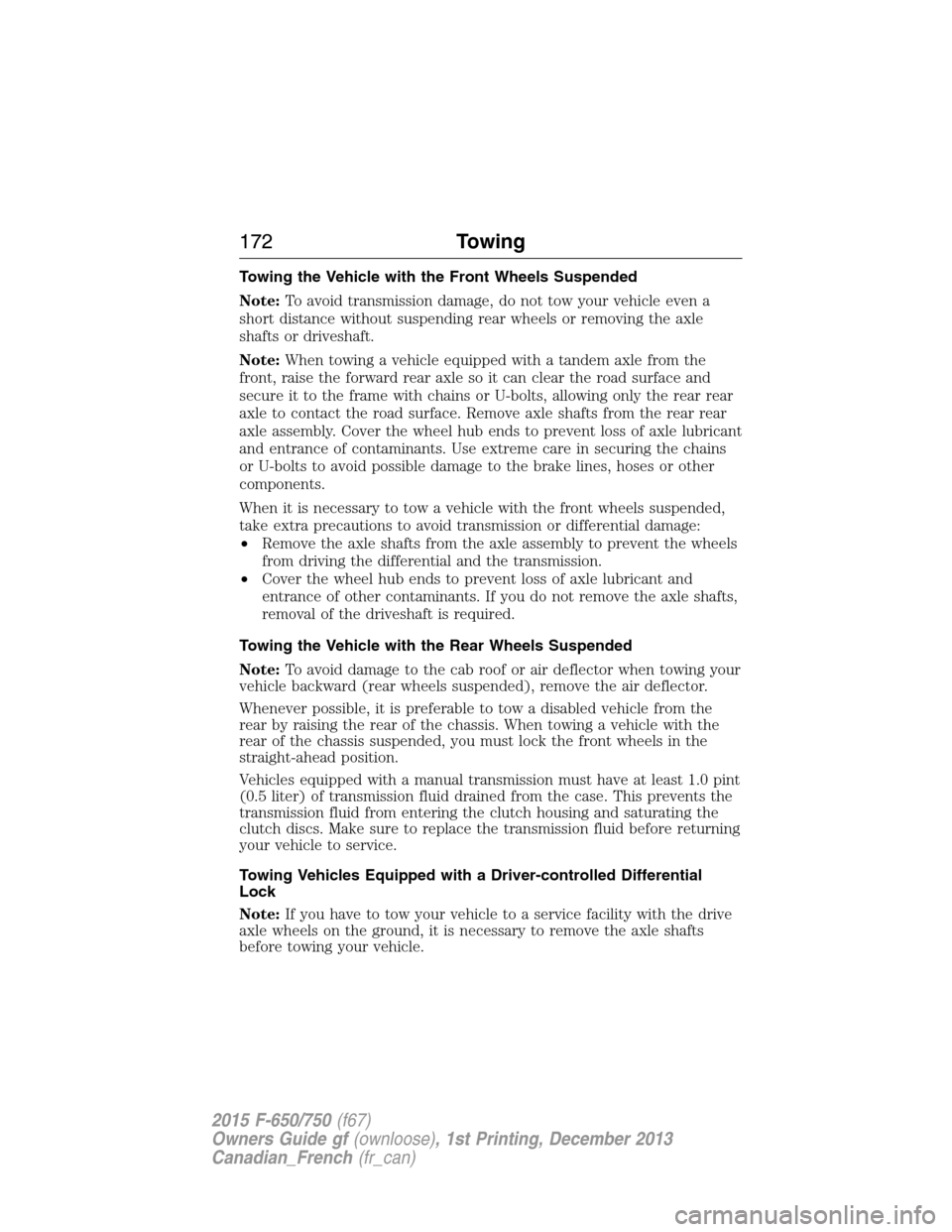
Towing the Vehicle with the Front Wheels Suspended
Note:To avoid transmission damage, do not tow your vehicle even a
short distance without suspending rear wheels or removing the axle
shafts or driveshaft.
Note:When towing a vehicle equipped with a tandem axle from the
front, raise the forward rear axle so it can clear the road surface and
secure it to the frame with chains or U-bolts, allowing only the rear rear
axle to contact the road surface. Remove axle shafts from the rear rear
axle assembly. Cover the wheel hub ends to prevent loss of axle lubricant
and entrance of contaminants. Use extreme care in securing the chains
or U-bolts to avoid possible damage to the brake lines, hoses or other
components.
When it is necessary to tow a vehicle with the front wheels suspended,
take extra precautions to avoid transmission or differential damage:
•Remove the axle shafts from the axle assembly to prevent the wheels
from driving the differential and the transmission.
•Cover the wheel hub ends to prevent loss of axle lubricant and
entrance of other contaminants. If you do not remove the axle shafts,
removal of the driveshaft is required.
Towing the Vehicle with the Rear Wheels Suspended
Note:To avoid damage to the cab roof or air deflector when towing your
vehicle backward (rear wheels suspended), remove the air deflector.
Whenever possible, it is preferable to tow a disabled vehicle from the
rear by raising the rear of the chassis. When towing a vehicle with the
rear of the chassis suspended, you must lock the front wheels in the
straight-ahead position.
Vehicles equipped with a manual transmission must have at least 1.0 pint
(0.5 liter) of transmission fluid drained from the case. This prevents the
transmission fluid from entering the clutch housing and saturating the
clutch discs. Make sure to replace the transmission fluid before returning
your vehicle to service.
Towing Vehicles Equipped with a Driver-controlled Differential
Lock
Note:If you have to tow your vehicle to a service facility with the drive
axle wheels on the ground, it is necessary to remove the axle shafts
before towing your vehicle.
172Towing
2015 F-650/750(f67)
Owners Guide gf(ownloose), 1st Printing, December 2013
Canadian_French(fr_can)
Page 174 of 384
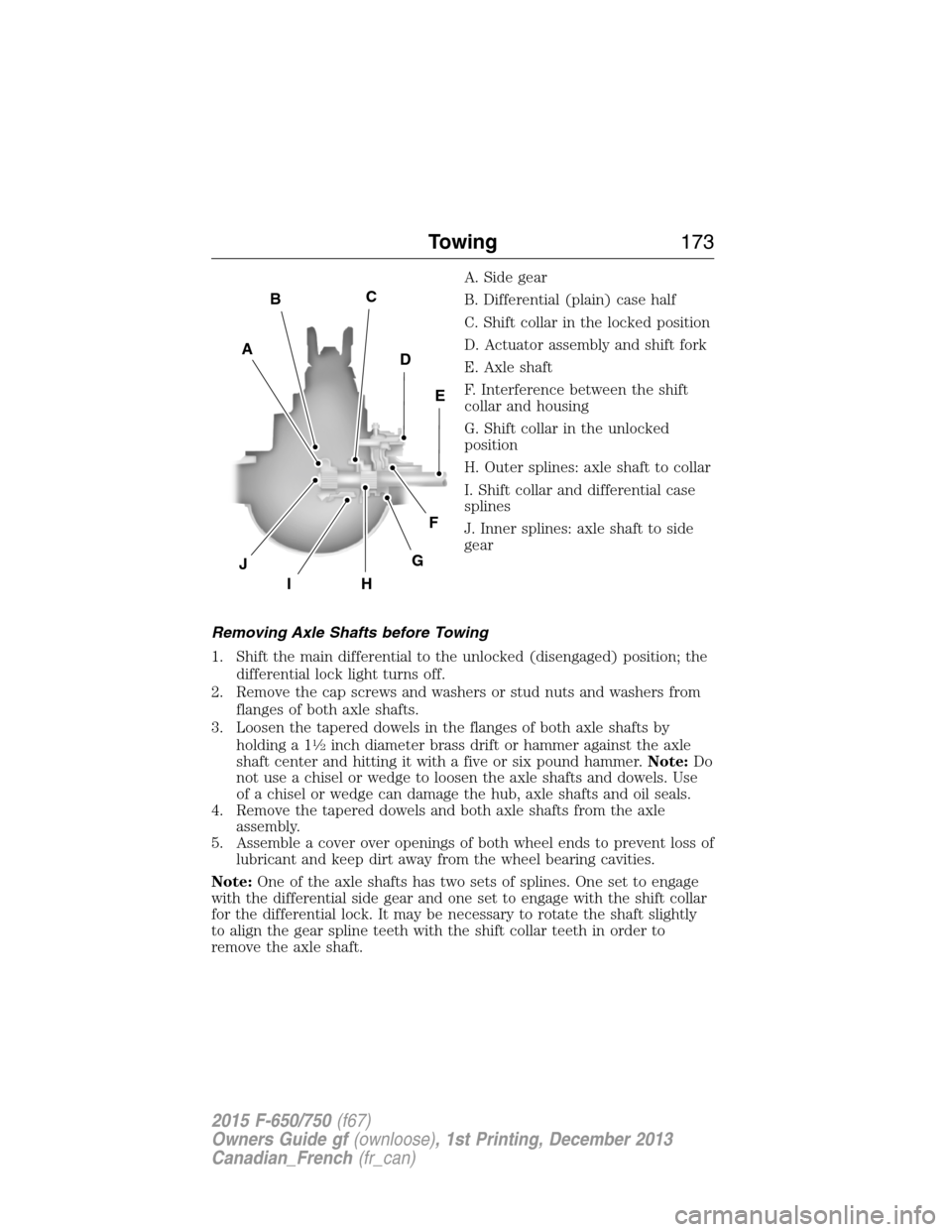
A. Side gear
B. Differential (plain) case half
C. Shift collar in the locked position
D. Actuator assembly and shift fork
E. Axle shaft
F. Interference between the shift
collar and housing
G. Shift collar in the unlocked
position
H. Outer splines: axle shaft to collar
I. Shift collar and differential case
splines
J. Inner splines: axle shaft to side
gear
Removing Axle Shafts before Towing
1. Shift the main differential to the unlocked (disengaged) position; the
differential lock light turns off.
2. Remove the cap screws and washers or stud nuts and washers from
flanges of both axle shafts.
3. Loosen the tapered dowels in the flanges of both axle shafts by
holding a 1
1�2inch diameter brass drift or hammer against the axle
shaft center and hitting it with a five or six pound hammer.Note:Do
not use a chisel or wedge to loosen the axle shafts and dowels. Use
of a chisel or wedge can damage the hub, axle shafts and oil seals.
4. Remove the tapered dowels and both axle shafts from the axle
assembly.
5. Assemble a cover over openings of both wheel ends to prevent loss of
lubricant and keep dirt away from the wheel bearing cavities.
Note:One of the axle shafts has two sets of splines. One set to engage
with the differential side gear and one set to engage with the shift collar
for the differential lock. It may be necessary to rotate the shaft slightly
to align the gear spline teeth with the shift collar teeth in order to
remove the axle shaft.
E
D
CB
A
J
IH
G
F
Towing173
2015 F-650/750(f67)
Owners Guide gf(ownloose), 1st Printing, December 2013
Canadian_French(fr_can)
Page 175 of 384
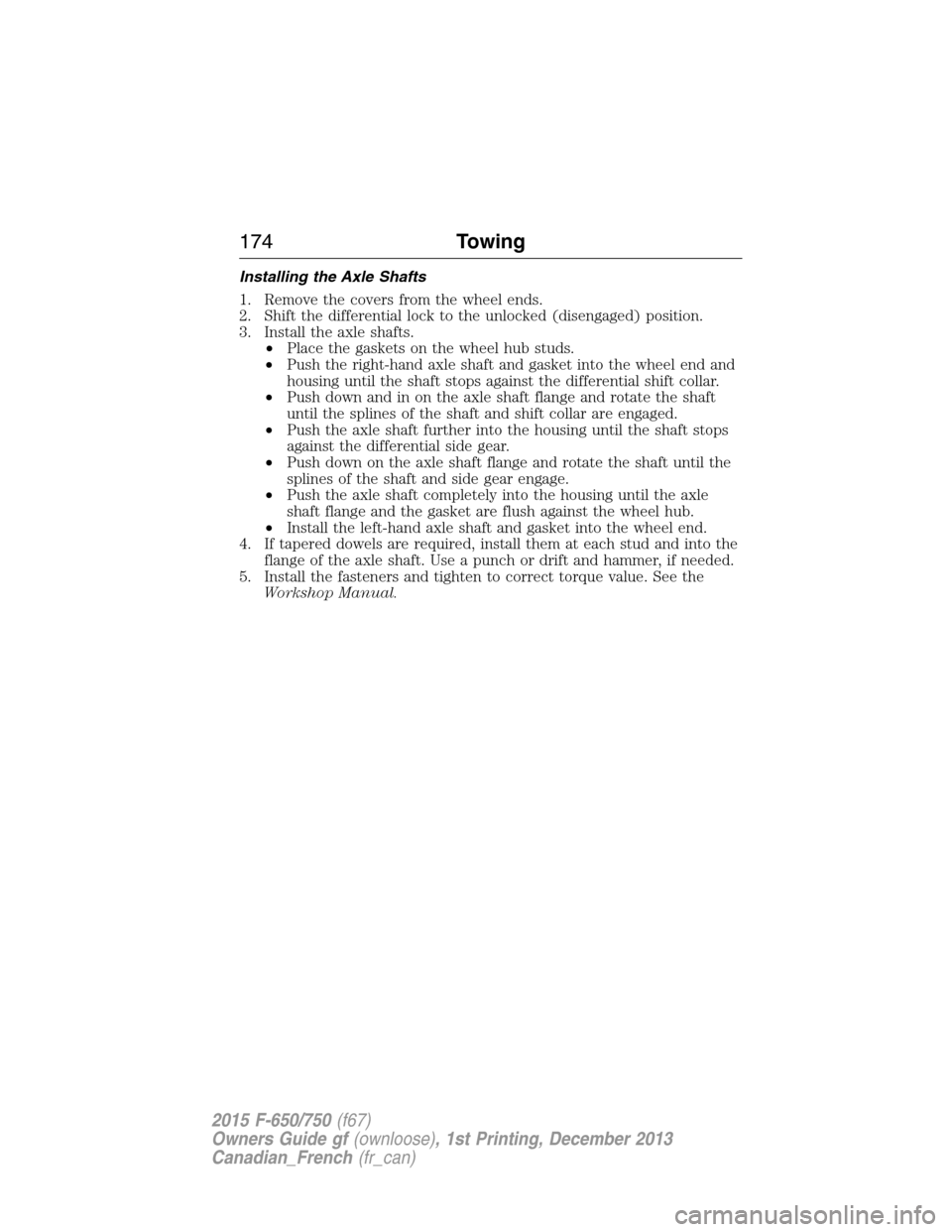
Installing the Axle Shafts
1. Remove the covers from the wheel ends.
2. Shift the differential lock to the unlocked (disengaged) position.
3. Install the axle shafts.
•Place the gaskets on the wheel hub studs.
•Push the right-hand axle shaft and gasket into the wheel end and
housing until the shaft stops against the differential shift collar.
•Push down and in on the axle shaft flange and rotate the shaft
until the splines of the shaft and shift collar are engaged.
•Push the axle shaft further into the housing until the shaft stops
against the differential side gear.
•Push down on the axle shaft flange and rotate the shaft until the
splines of the shaft and side gear engage.
•Push the axle shaft completely into the housing until the axle
shaft flange and the gasket are flush against the wheel hub.
•Install the left-hand axle shaft and gasket into the wheel end.
4. If tapered dowels are required, install them at each stud and into the
flange of the axle shaft. Use a punch or drift and hammer, if needed.
5. Install the fasteners and tighten to correct torque value. See the
Workshop Manual.
174Towing
2015 F-650/750(f67)
Owners Guide gf(ownloose), 1st Printing, December 2013
Canadian_French(fr_can)
Page 176 of 384
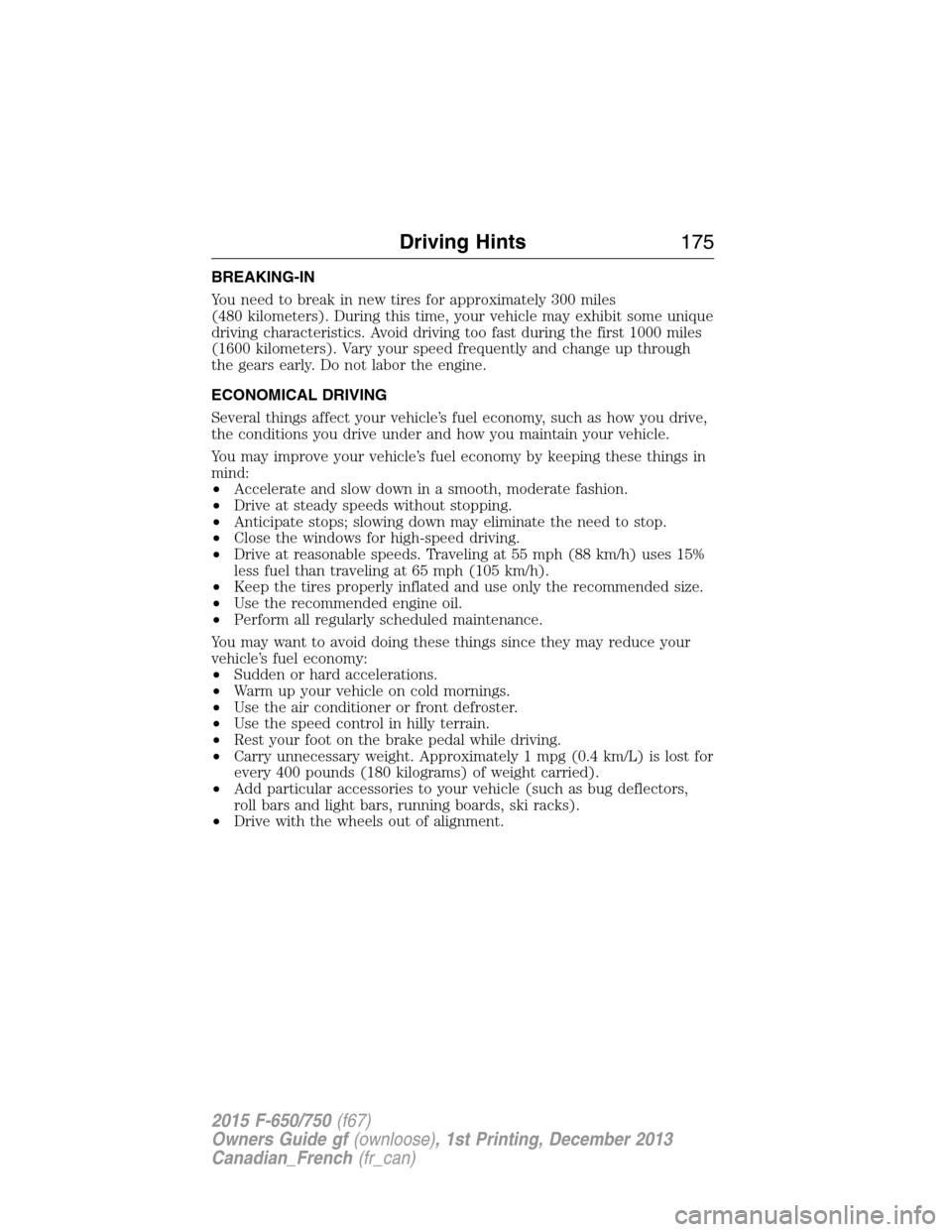
BREAKING-IN
You need to break in new tires for approximately 300 miles
(480 kilometers). During this time, your vehicle may exhibit some unique
driving characteristics. Avoid driving too fast during the first 1000 miles
(1600 kilometers). Vary your speed frequently and change up through
the gears early. Do not labor the engine.
ECONOMICAL DRIVING
Several things affect your vehicle’s fuel economy, such as how you drive,
the conditions you drive under and how you maintain your vehicle.
You may improve your vehicle’s fuel economy by keeping these things in
mind:
•Accelerate and slow down in a smooth, moderate fashion.
•Drive at steady speeds without stopping.
•Anticipate stops; slowing down may eliminate the need to stop.
•Close the windows for high-speed driving.
•Drive at reasonable speeds. Traveling at 55 mph (88 km/h) uses 15%
less fuel than traveling at 65 mph (105 km/h).
•Keep the tires properly inflated and use only the recommended size.
•Use the recommended engine oil.
•Perform all regularly scheduled maintenance.
You may want to avoid doing these things since they may reduce your
vehicle’s fuel economy:
•Sudden or hard accelerations.
•Warm up your vehicle on cold mornings.
•Use the air conditioner or front defroster.
•Use the speed control in hilly terrain.
•Rest your foot on the brake pedal while driving.
•Carry unnecessary weight. Approximately 1 mpg (0.4 km/L) is lost for
every 400 pounds (180 kilograms) of weight carried).
•Add particular accessories to your vehicle (such as bug deflectors,
roll bars and light bars, running boards, ski racks).
•Drive with the wheels out of alignment.
Driving Hints175
2015 F-650/750(f67)
Owners Guide gf(ownloose), 1st Printing, December 2013
Canadian_French(fr_can)
Page 177 of 384
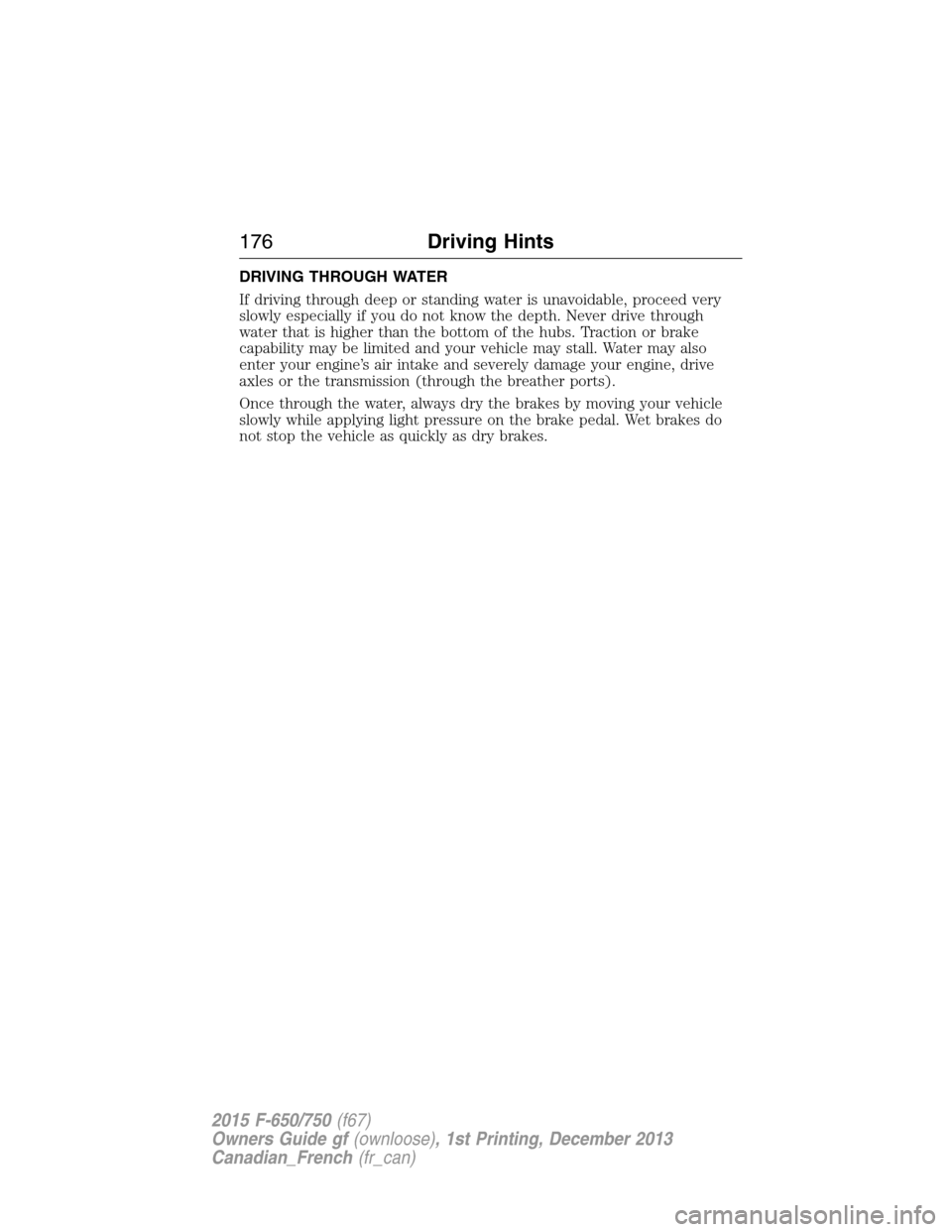
DRIVING THROUGH WATER
If driving through deep or standing water is unavoidable, proceed very
slowly especially if you do not know the depth. Never drive through
water that is higher than the bottom of the hubs. Traction or brake
capability may be limited and your vehicle may stall. Water may also
enter your engine’s air intake and severely damage your engine, drive
axles or the transmission (through the breather ports).
Once through the water, always dry the brakes by moving your vehicle
slowly while applying light pressure on the brake pedal. Wet brakes do
not stop the vehicle as quickly as dry brakes.
176Driving Hints
2015 F-650/750(f67)
Owners Guide gf(ownloose), 1st Printing, December 2013
Canadian_French(fr_can)
Page 178 of 384
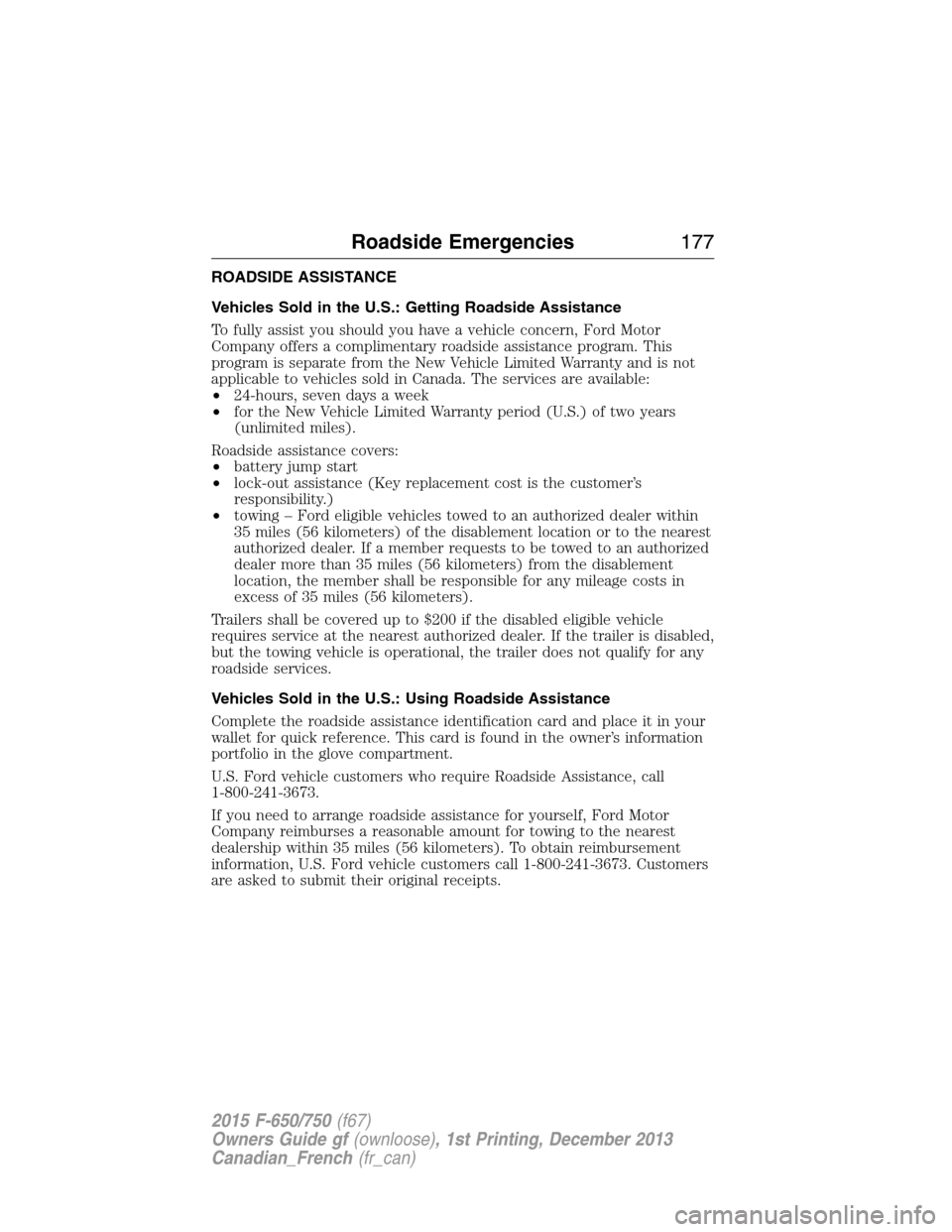
ROADSIDE ASSISTANCE
Vehicles Sold in the U.S.: Getting Roadside Assistance
To fully assist you should you have a vehicle concern, Ford Motor
Company offers a complimentary roadside assistance program. This
program is separate from the New Vehicle Limited Warranty and is not
applicable to vehicles sold in Canada. The services are available:
•24-hours, seven days a week
•for the New Vehicle Limited Warranty period (U.S.) of two years
(unlimited miles).
Roadside assistance covers:
•battery jump start
•lock-out assistance (Key replacement cost is the customer’s
responsibility.)
•towing – Ford eligible vehicles towed to an authorized dealer within
35 miles (56 kilometers) of the disablement location or to the nearest
authorized dealer. If a member requests to be towed to an authorized
dealer more than 35 miles (56 kilometers) from the disablement
location, the member shall be responsible for any mileage costs in
excess of 35 miles (56 kilometers).
Trailers shall be covered up to $200 if the disabled eligible vehicle
requires service at the nearest authorized dealer. If the trailer is disabled,
but the towing vehicle is operational, the trailer does not qualify for any
roadside services.
Vehicles Sold in the U.S.: Using Roadside Assistance
Complete the roadside assistance identification card and place it in your
wallet for quick reference. This card is found in the owner’s information
portfolio in the glove compartment.
U.S. Ford vehicle customers who require Roadside Assistance, call
1-800-241-3673.
If you need to arrange roadside assistance for yourself, Ford Motor
Company reimburses a reasonable amount for towing to the nearest
dealership within 35 miles (56 kilometers). To obtain reimbursement
information, U.S. Ford vehicle customers call 1-800-241-3673. Customers
are asked to submit their original receipts.
Roadside Emergencies177
2015 F-650/750(f67)
Owners Guide gf(ownloose), 1st Printing, December 2013
Canadian_French(fr_can)
Page 179 of 384
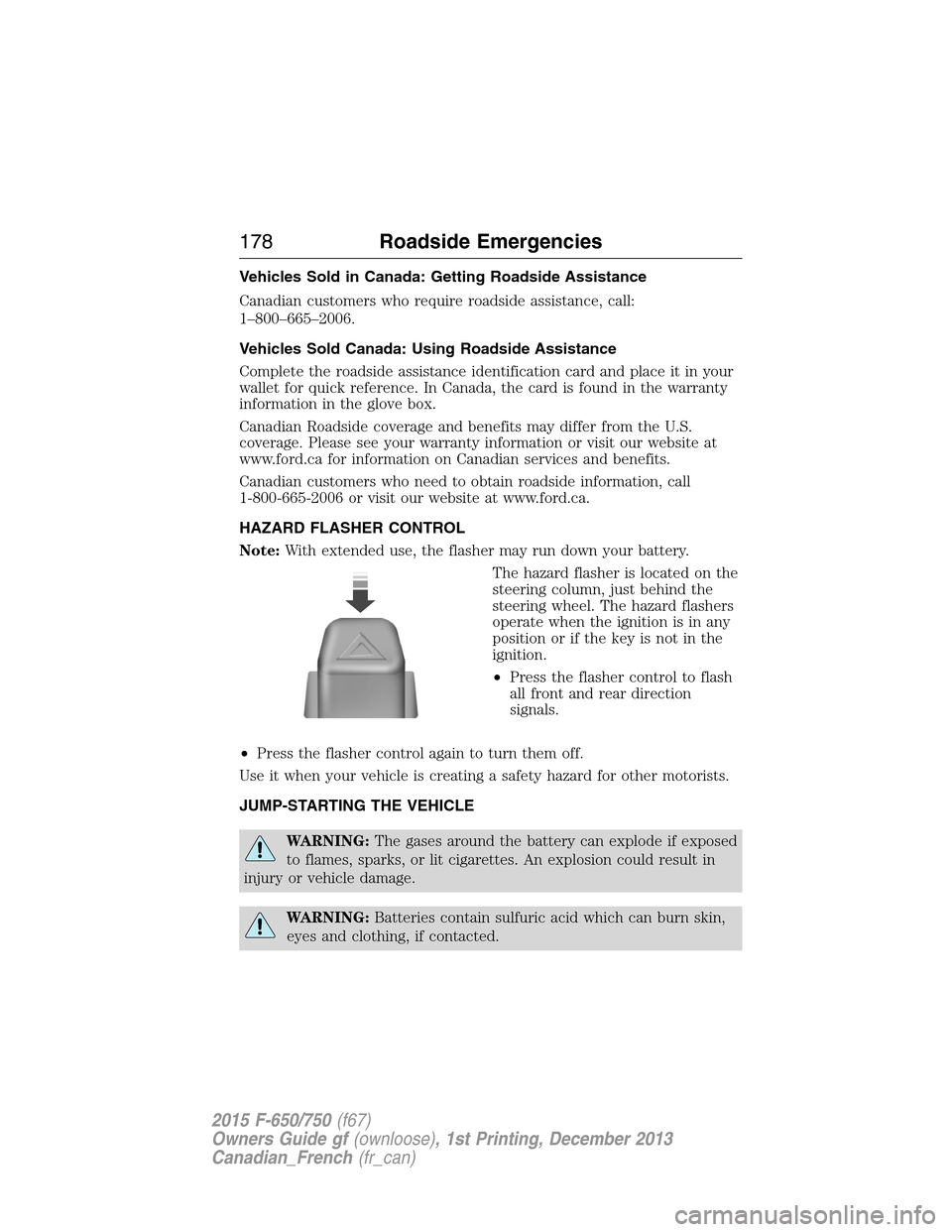
Vehicles Sold in Canada: Getting Roadside Assistance
Canadian customers who require roadside assistance, call:
1–800–665–2006.
Vehicles Sold Canada: Using Roadside Assistance
Complete the roadside assistance identification card and place it in your
wallet for quick reference. In Canada, the card is found in the warranty
information in the glove box.
Canadian Roadside coverage and benefits may differ from the U.S.
coverage. Please see your warranty information or visit our website at
www.ford.ca for information on Canadian services and benefits.
Canadian customers who need to obtain roadside information, call
1-800-665-2006 or visit our website at www.ford.ca.
HAZARD FLASHER CONTROL
Note:With extended use, the flasher may run down your battery.
The hazard flasher is located on the
steering column, just behind the
steering wheel. The hazard flashers
operate when the ignition is in any
position or if the key is not in the
ignition.
•Press the flasher control to flash
all front and rear direction
signals.
•Press the flasher control again to turn them off.
Use it when your vehicle is creating a safety hazard for other motorists.
JUMP-STARTING THE VEHICLE
WARNING:The gases around the battery can explode if exposed
to flames, sparks, or lit cigarettes. An explosion could result in
injury or vehicle damage.
WARNING:Batteries contain sulfuric acid which can burn skin,
eyes and clothing, if contacted.
178Roadside Emergencies
2015 F-650/750(f67)
Owners Guide gf(ownloose), 1st Printing, December 2013
Canadian_French(fr_can)
Page 180 of 384
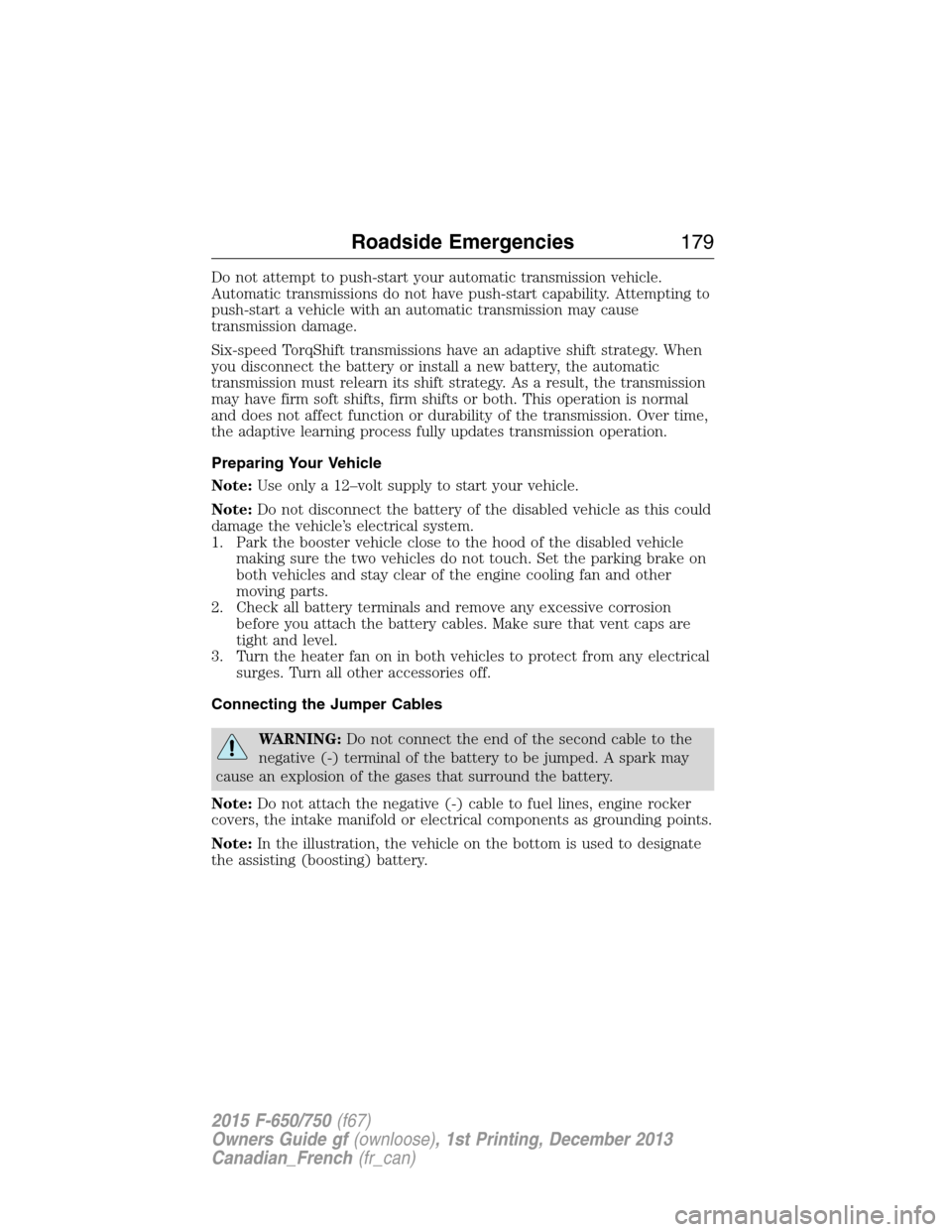
Do not attempt to push-start your automatic transmission vehicle.
Automatic transmissions do not have push-start capability. Attempting to
push-start a vehicle with an automatic transmission may cause
transmission damage.
Six-speed TorqShift transmissions have an adaptive shift strategy. When
you disconnect the battery or install a new battery, the automatic
transmission must relearn its shift strategy. As a result, the transmission
may have firm soft shifts, firm shifts or both. This operation is normal
and does not affect function or durability of the transmission. Over time,
the adaptive learning process fully updates transmission operation.
Preparing Your Vehicle
Note:Use only a 12–volt supply to start your vehicle.
Note:Do not disconnect the battery of the disabled vehicle as this could
damage the vehicle’s electrical system.
1. Park the booster vehicle close to the hood of the disabled vehicle
making sure the two vehicles do not touch. Set the parking brake on
both vehicles and stay clear of the engine cooling fan and other
moving parts.
2. Check all battery terminals and remove any excessive corrosion
before you attach the battery cables. Make sure that vent caps are
tight and level.
3. Turn the heater fan on in both vehicles to protect from any electrical
surges. Turn all other accessories off.
Connecting the Jumper Cables
WARNING:Do not connect the end of the second cable to the
negative (-) terminal of the battery to be jumped. A spark may
cause an explosion of the gases that surround the battery.
Note:Do not attach the negative (-) cable to fuel lines, engine rocker
covers, the intake manifold or electrical components as grounding points.
Note:In the illustration, the vehicle on the bottom is used to designate
the assisting (boosting) battery.
Roadside Emergencies179
2015 F-650/750(f67)
Owners Guide gf(ownloose), 1st Printing, December 2013
Canadian_French(fr_can)